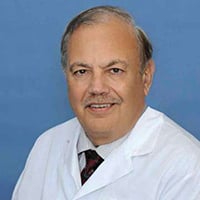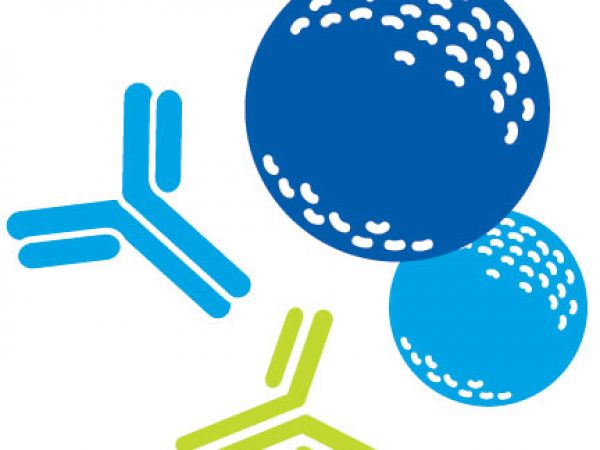25 Years of Trastuzumab: A Legacy of Innovation
The AACR Annual Meeting 2023, held April 14-19, commemorated several milestones, including the 25th anniversary of the approval of the blockbuster breast cancer drug trastuzumab (Herceptin).
Coincidentally, Lisa Coussens, PhD, MD (hc), FAACR, FAIO, who closed out her term as AACR President during the meeting, played a significant role in the story of trastuzumab. In 1985, as a postdoctoral fellow in the lab of Axel Ullrich, PhD, FAACR, Coussens and colleagues cloned the gene HER2, which encoded a cell surface receptor that could drive cell growth and proliferation. A few years later, researchers discovered that overexpression of HER2 drove the growth of breast tumors.
One solution was to stymie the progression of cancers that express the HER2 receptor with the antibody trastuzumab, which blocks the function of HER2.
“The impact of trastuzumab has been huge. It changed drug discovery in pharma and biotech,” said, H. Michael Shepard, PhD, president, Chief Executive Officer, and Chief Scientific Officer of Enosi Therapeutics, during the Annual Meeting session honoring the anniversary of trastuzumab’s approval. “This program created the current paradigm for biomarker-driven drug discovery and development.”
In 2019, Shepard, Ullrich, and Dennis Slamon, MD, PhD, FAACR, won the Lasker-DeBakey Clinical Medical Research Award for the development of trastuzumab—a prestigious achievement, but far from the only recognition the drug has received. The Galien Foundation named trastuzumab Best Biotech Product of the Year in 2000 and Best Biotech Product of the Last 50 Years in 2022.
Although trastuzumab transformed the landscape of breast cancer therapy at the time of its approval, Shepard emphasized that, “Trastuzumab was a good first step, not the whole thing.” He explained that its full impact would be largely shaped by the treatments it inspired.
The Journey to Approval

Slamon, director of Clinical/Translational Research and the Revlon/UCLA Women’s Cancer Research Program at the University of California Los Angeles Jonsson Comprehensive Cancer Center, set the stage by describing the landscape of cancer research in the mid- to late-1980s, when HER2 was first discovered.
“Cancer was identified, characterized, and classified by the organ in which it occurred,” Slamon said, explaining that each tumor type was “treated with … a one-size-fits-all approach.”
The concepts of targeted therapy and cancer subtyping were only beginning to emerge. Therefore, Slamon and colleagues’ 1987 findings that the HER2 gene was amplified or rearranged in around 30% of breast cancers and that these modifications correlated with a poorer prognosis were striking. In a follow-up paper, the researchers confirmed that HER2 overexpression could drive tumor growth in preclinical models.
So how could researchers block it?
The answer came serendipitously, explained Gail Lewis, PhD, a senior principal scientist of technology and translational oncology at Genentech. Lewis and colleagues designed a HER2-targeted antibody to demonstrate that blocking HER2 boosts the efficacy of another breast cancer therapy under development. Instead, they found that the antibody was quite effective on its own.
The team pivoted toward developing a therapeutic antibody, although the odds at the time were not in their favor. “People had tried antibodies for years, and they hadn’t worked, especially in solid tumor indications,” Lewis said. “There was a lot of skepticism about that.”

To use their mouse-derived antibodies in the clinic, the researchers had to humanize them, replacing several of the antibody’s mouse pieces with human pieces so the patient’s immune system would not reject the therapy. Systems to produce humanized antibodies at a therapeutic scale were not yet developed.
Nevertheless, the candidate antibody 4D5, which would be developed into trastuzumab, was successfully humanized and entered phase I clinical trials by 1992.
After years of clinical testing, trastuzumab became the first fully humanized antibody to be approved by the U.S. Food and Drug Administration (FDA) in 1998. In the phase III trial on which the approval was based, patients with treatment-naïve, HER2-overexpressing breast tumors treated with chemotherapy plus trastuzumab had a longer time to disease progression, a longer duration of response, and a 20% lower risk of death than those treated with chemotherapy alone.
In 2006, trastuzumab plus chemotherapy was approved to treat patients after their HER2-overexpressing breast tumors were surgically removed. Around this time, researchers also discovered that HER2 is sometimes overexpressed in other cancer types, including gastric cancer. In 2010, trastuzumab plus chemotherapy was approved to treat HER2-overexpressing cancers of the stomach and the gastroesophageal junction.
An Inspiration for Other HER2-targeted Therapies
The clinical success of trastuzumab spurred researchers to explore similar therapies targeting HER2.
Small molecule inhibitors. In 2001, the FDA approved the first tyrosine kinase inhibitor (TKI), opening the door for the development of drugs targeting other tyrosine kinases, such as HER2.
The same year, researchers developed lapatinib (Tykerb), a small molecule inhibitor of HER2 and its close cousin, the epidermal growth factor receptor (EGFR). Lapatinib earned FDA approval in 2007, in combination with the chemotherapy capecitabine (Xeloda), for patients with metastatic HER2-positive breast cancer who did not respond to or relapsed following treatment with trastuzumab. The combination received accelerated approval for use in the first-line setting in 2010.
Scientists developed new generations of HER2-targeted TKIs to overcome resistance, increase specificity, and treat patients who didn’t respond to other HER2-targeting therapies. Neratinib (Nerlynx) in combination with capecitabine was approved to treat early-stage breast cancer in 2017 and metastatic breast cancer in 2020. Tucatinib (Tukysa), the only currently approved HER2 inhibitor that exclusively inhibits HER2, was approved, in combination with trastuzumab and capecitabine, to treat advanced or metastatic breast cancer in 2020. Tucatinib plus trastuzumab received an accelerated approval to treat HER2-positive colorectal cancer in 2023.
Other antibodies. The success of trastuzumab also drove researchers to re-examine other HER2-targeted antibodies developed alongside trastuzumab. One would later become known as pertuzumab (Perjeta), and researchers found it had a different mechanism of action than trastuzumab.
To activate downstream signaling, one HER2 molecule must partner with another, or with a molecule of the related receptor HER3. While trastuzumab prevented HER2 molecules from forming dimers with each other, pertuzumab prevented HER2 from dimerizing with HER3. Therefore, researchers hypothesized that combining both antibodies may improve HER2 inhibition by blocking both of its signaling outlets.
In a phase III clinical trial, patients with HER2-positive metastatic breast cancer had a median progression-free survival of 18.5 months when treated with pertuzumab, trastuzumab, and docetaxel, as compared with 12.4 months when treated with trastuzumab and docetaxel alone.
These data led to the 2012 FDA approval of trastuzumab, pertuzumab, and docetaxel for patients with HER2-overexpressing metastatic breast cancer. In 2013, the combination was granted an accelerated approval for use earlier in a patient’s treatment plan, prior to surgery. The accelerated approval was converted to a full approval in 2017, at the same time that the combination was approved to treat certain early-stage breast cancers after surgery as well.
Antibody-drug conjugates. A new technology that emerged in the early 2000s linked cancer-targeting antibodies to toxic payloads for highly targeted tumor cell killing. Researchers sought to develop such an antibody-drug conjugate (ADC) to target HER2.
In 2008, they developed trastuzumab emtansine (Kadcyla, T-DM1), an ADC consisting of a trastuzumab antibody bound to the drug emtansine, which disrupts the microtubules that form part of a cell’s internal skeleton. In a phase III clinical trial, patients with metastatic breast cancer that was previously treated with at least one HER2-targeting therapy had a 45% lower risk of disease progression or death when treated with T-DM1, as compared with patients treated with lapatinib plus chemotherapy. These data led to the 2013 approval of T-DM1 for this indication.
While T-DM1 underwent clinical development, researchers sought opportunities to improve upon its design, and they produced another ADC called trastuzumab deruxtecan (Enhertu, T-DXd). Deruxtecan, the toxic payload of T-DXd, blocks an enzyme crucial for DNA replication.
Deruxtecan can also diffuse through the cell membrane, meaning it can pass out of targeted cells and kill nearby tumor cells with variable HER2 expression. Further, T-DXd packs an average of eight drug molecules onto each trastuzumab backbone, compared to T-DM1’s average of four.
In 2019, researchers demonstrated that T-DXd was effective in patients previously treated with T-DM1, which led to the accelerated approval of T-DXd for patients with metastatic breast cancer who had received two prior lines of HER2-targeted therapy. The full approval came in 2022 following a head-to-head comparison of T-DXd to T-DM1, which showed significant benefits in overall survival, progression-free survival, and overall response rate in patients receiving T-DXd.
Meanwhile, researchers noticed that, unlike other HER2-targeted therapies, T-DXd was effective in preclinical models with low or normal expression of HER2. In clinical studies, patients with previously treated HER2-low tumors experienced a median progression-free survival of 9.9 months and an overall survival of 23.4 months when treated with T-DXd, compared with 5.1 months and 16.8 months, respectively, when treated with chemotherapy. These data resulted in the approval of T-DXd in 2022 for patients with unresectable or metastatic HER2-low tumors after at least one prior line of chemotherapy.
The Future of HER2 Targeting
The presenters also offered ideas about HER2-targeting therapies that may emerge in the future.
Lewis discussed bispecific antibodies—molecules that contain two antibody fragments targeting different proteins or different sites on the same protein. In some cases, the goal of bispecific antibodies can be to double down on inhibition; a bispecific antibody comprised of trastuzumab and pertuzumab, for example, could enhance the HER2 blockade. Similarly, a bispecific antibody targeting both HER2 and HER3 could interfere with both signaling pathways to optimally block tumor growth.

Bispecific antibodies can also bring cancer cells and immune cells together to boost immune-mediated tumor killing. Lewis mentioned bispecific antibodies with trastuzumab as one arm and either a T-cell engager, such as an antibody targeting CD3, or a natural killer-cell engager, such as an antibody targeting CD16, as the other arm.
“All of this really shows that trastuzumab has laid the background for developing antibody-based therapies against HER2-positive cancers,” Lewis said.
But what happens when patients develop resistance to existing HER2-targeted therapies? HER2 typically retains its strong expression despite no longer driving the tumor, explained Gregory Frost, PhD, chairman and CEO of Exuma Biotech.
“While the biology may change, the argument is that, in some cases, the presence of HER2 through amplification still remains, to leave it potentially as a viable target for other modalities of therapy,” Frost said.
Frost and colleagues have been developing a CAR T-cell therapy that targets HER2—a difficult task considering the baseline levels of HER2 expression in many normal tissues. One of their designs is a “logic-gated” CAR T cell that only attacks targets at a low pH, such as in the tumor microenvironment.
In preclinical models, the cells promoted tumor regression while sparing normal tissues. These data have spurred a clinical trial to test these CAR T cells in patients with metastatic solid tumors that express HER2. While clinical activity data remain immature, patients treated at the highest dose level showed evidence of CAR T cells circulating in the blood as well as preliminary hints of tumor shrinkage.
“What we’d like to conclude is that, if HER2 remains amplified and accessible, cellular therapy approaches might one day provide us another arrow in the quiver for HER2-amplified malignancies,” Frost said.
To view the original FDA press releases for approvals issued between 2006 and 2016, check out the FDA’s Hematology/Oncology Approvals & Safety Notifications archive site. To stay abreast of new FDA approvals for cancer indications, including those for HER2-expressing malignancies, visit the AACR FDA Approvals page



